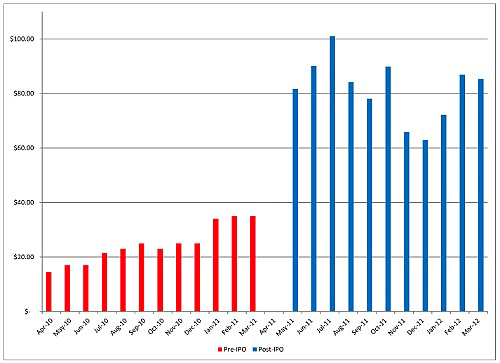
| April 11, 2012 | Issue #115-2 |
ASA/RICS ‘strongly oppose’ SBA’s proposal to permit real estate appraisers to value special-use properties Last week, the American Society of Appraisers joined forces with the Royal Institution of Chartered Surveyors (Americas) to express their “strong opposition” to SOP 50 10 5(D), a proposal by the Small Business Administration that would permit real estate appraisers to perform business valuations for special use properties after successfully completing a single course (“Fundamentals of Separating Real and Personal Property From Intangible Business Assets”) offered by the Appraisal Institute. In a letter signed by Jay Fishman, chair of the ASA’s government relations committee, and Bruce Bingham, chair of RICS Americas valuation council, the two organizations told the SBA’s deputy assistant administrator, James Hammersley, that the AI course teaches a “fundamentally flawed” approach to valuation. Moreover, they point to provisions of the SOP that direct appraisers not only to categorize a firm’s assets, but also to separately value the property in each category:
The two organizations “pledge to work with the SBA” as well as members of the various appraisal communities to revise and/or strengthen the SOP, but in the meantime, they urge the SBA to immediately suspend its operation until it can establish proper educational and testing requirements for real estate appraisers to value business interests. Read the ASA/RICS complete letter, its six points of opposition and recommendations, here. New article assesses impact of private secondary markets on value—and promises pre- and post-IPO pricing comparisons Do trades on private secondary markets reflect fair market value—or fair value? Do the investors buying these securities represent market participants? Can secondary market transactions be considered orderly? These are just a few of the questions that a new, two-part article by Neil Beaton (Alvarez & Marsal) attempts to answer. Part 1, currently posted online, examines the development and operation of private secondary markets and then explores their impact on FMV as well as fair value (under ASC 820). To the ultimate question—whether secondary market transactions accurately reflect value under any standard—Beaton’s answer is “it depends” on the specific facts and circumstances:
In Part 2 of his article, coming exclusively to BVR this summer, Beaton promises an empirical analysis of the accuracy (or lack thereof) of secondary market prices when the same companies that have been trading on these platforms subsequently complete an IPO. As a teaser, he offers this chart, showing the pre-IPO prices of a company’s common stock traded on a secondary market and its post-IPO share. “Can you guess the stock?” Beaton asks. New list of free, state economic resources available at BVR Adam Manson, BVR’s manager of financial research, has just compiled a comprehensive list of all the free economic information that’s available online for each of the 50 United States and three territories. We’ve posted this new “State-by-State Summary of Economic Information” at the top of BVR’s free downloads. Manson is hoping to keep the list as current and complete as possible. “If you use any free sources that aren’t available on this list, please share them with us and we will add them,” he says. Please send state economic source contributions to adamm@bvresources.com. The clear and present ‘dangers’ of normalizing interest rates, according to Morningstar “Normalizing interest rates are becoming routine for many business valuation professionals when developing a discount rate in the current environment and as part of a World War II [equity risk premium] adjustment,” says a new article by Kevin Piccolo and Mike Barad (both Morningstar) titled “The Dangers of Normalization: An Interest Rate Perspective.” In a video interview, the authors discuss the highlights of their article, including:
The video also includes brief commentary by Roger Grabowski (Duff & Phelps) and Aswath Damodaran (NYU Stern School of Business). One-stop resource for all estate and gift valuation cases Where else can you find all of the leading valuation case law in estate and gift tax? In the 2012 edition of BVR’s Business Valuation Issues in Estate & Gift Tax/Case Law Compendium, of course. The just-published compendium contains over 200 court cases, dating back to 1993, that cover such important topics as deriving the discount for lack of marketability, preserving the form (and fair market value) of family limited partnerships, determining reasonable compensation for corporate executives, and more. This new edition also contains the most current estate and gift tax cases, such as the Estate of Gallagher v. Commissioner, in which the Tax Court tackled the viability of the market approach as well as common inputs and assumptions to the income approach (discounted cash flow), and Boltar v. Commissioner, in which the court found (for the first time) that a conservation easement appraisal didn’t meet the rigorous standards of Daubert. The print compendium contains case digests of all estate and gift tax decisions, plus a summary table for quick reference. An enclosed CD provides the full text of the court’s decisions and features a sophisticated indexing system that searches all the cases by key words. As part of its ongoing mission to issue “best practice” guidance on recognized valuation methods and techniques, the Appraisal Practices Board is currently seeking BV experts to suggest possible areas and/or topics for its next consideration. “Issues may include emerging valuation methodology, conflicts in present practice, or conflicts among existing authorities,” the APB says in a recent announcement. BV topics that the board’s working groups have already completed (or are currently developing) include:
These topics are intended “to stimulate your thinking,” the APB says. BV analysts should send their suggestions for future topics—with an explanation of their importance—to Staci Steward at the Appraisal Practices Board, c/o The Appraisal Foundation,1155 15th Street, NW, Suite 1111, Washington, DC 20005; staci@appraisalfoundation.org. Bounce back from the busy season with new CPE On April 26, join Mike Pellegrino for Valuing Early Stage Companies and a discussion of the more difficult aspects of appraising startups and new ventures, including intangible asset valuation, treatment of small revenue streams, and how to assess unproven business plans and product concepts. On April 24, BVR’s Online Symposium on Healthcare Valuation continues with Part 4: Valuation of Medical Laboratories, featuring Curtis Bernstein, Kyle Rudduck (both Altegra Health), and Amy Graham. New subscribers can also take advantage of just-reduced prices for the remaining nine parts of the Healthcare Symposium; to learn more, click here. Latest Insights on income tax valuation issues The spring 2012 edition of Insights, the quarterly publication by Willamette Management Associates, focuses on income taxes and valuation. Over a dozen articles address topics such as:
In addition, Willamette has just posted online the entire Winter 2012 Insights, with its special focus on valuation in property tax valuation practices. BV and divorce conference coming in May On May 10-11, the AICPA/AAML will once again sponsor their biennial national conference on divorce in Las Vegas. As in prior years, each session will feature an attorney and a BV appraiser speaking to both the legal and valuation sides of a particular issue. This year, look for these prominent teams to take on such timely topics as:
For more information and a complete conference agenda, click here. All the news from north of the border The Canadian Institute of Chartered Business Valuators (CICBV) has just published its Spring 2012 newsletter. Featured in this issue: new educational offerings, upcoming events—including the CICBV national BV conference in September—election updates, and association awards, plus a useful article on proper citation format in valuation reports.
To ensure this email is delivered to your inbox, please add editor@bvwire.com to your e-mail address book. We respect your online time and privacy and pledge not to abuse this medium. To unsubscribe to BVWire™ reply to this e-mail with 'REMOVE BVWire' in the subject line or use the link below. This email was sent to %%emailaddress%% Copyright © 2012 by Business Valuation Resources, LLC |
|




